The researchers fitted the birds with tiny tracking devices to see precisely which routes the animals took on their 70,000km (43,000 miles) round trip.
The study reveals they fly down either the African or Brazilian coasts but then return in an "S"-shaped path up the middle of the Atlantic Ocean.
"The new thing is that we've now been able to track the bird during a full year of migration, all the way from the breeding grounds to the wintering grounds and back again."
Albatrosses, godwits, and sooty shearwaters all undertake epic journeys. But none can quite match the Arctic tern's colossal trip.
Starting in August and September, this small bird - which weighs little more than 100g (3.5oz) - will head away from Greenland with the intention of getting to the Weddell Sea, on the shores of Antarctica.
It will spend about four or five months in the deep south before heading back to the far north, arriving back to The Farne Islands in May.
A team from Greenland, Denmark, the US, the UK and Iceland attached small (1.4g/0.05oz) "geolocators" to the animals to find out exactly where they went on this polar round trip.
The devices record light intensity. This gives an estimate of the local day length, and the times of sunrise and sunset; and from this information it is possible to work out a geographical position of the birds.
The use of these devices on seabirds is not only revolutionising our understanding of migration patterns, but the resulting data on distribution also help address the requirement to identify important biological hot spots.
With such a small bird, the trackers also need to be tiny
The first surprise is that the terns do not make straight for the Antarctic when they leave the Arctic, but make a lengthy stop-over in the middle of the North Atlantic, about 1,000km (620 miles) north of the Azores.
Here, they feed on zoo plankton and fish to fuel themselves for the long journey ahead.
Even more importantly, it's the last high productive area before they enter tropical waters where we know productivity is low.
The birds then head south along the coast of western Europe and western Africa before making a choice, either to continue hugging Africa or sweep across the Atlantic from the Cape Verde Islands to continue the journey along the Brazilian coast.
About half the birds that were tracked decided to take the South American path. It is not clear why, but the researchers believe wind might make either route seem favourable to the terns.
After spending their northern winter months in Antarctic waters, the terns then fly back towards the Arctic.
But rather than retracing their southward flight paths, the birds follow a gigantic "S" pattern up the middle of the Atlantic Ocean.
They make a detour of several thousand km but once we start comparing the route to the prevailing wind system, it makes perfect sense - moving in a counter-clockwise direction in the Southern Hemisphere, and clockwise in the Northern Hemisphere.
It's just more energy-efficient for them to do that even though they are travelling several thousand more km than if they flew in a straight line.
With the bird so small the trackers need to be tiny.
So when our customers ask why do the Arctic Terns dive bomb you and peck you on your head. We aways say that they are protecting their eggs or chicks, and after travelling those sort of distances then I think they have a right to do so. We tend to forget sometimes that we are invading the birds home and this is one of the main reasons why the National Trust only open Staple Island in the morning and the Inner Farne in the afternoon.
One of the guys that ring the Arctic Terns on The Inner Farne and check their details evey year.
Sorting the trap to catch them.
Ready to be released after getting all the details from the ring.
Arctic Tern sitting on the wall at the lighthouse on the Inner Farne.
And this is why they dive bomb us, and who can blame them after travelling all that way.































